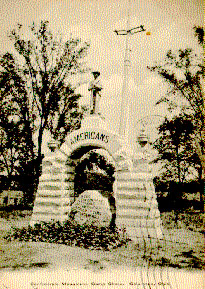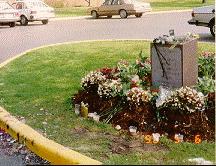Healing/Remembering/Forgetting
Both The Camp Chase Confederate Cemetery
and The May Fourth Memorial acknowledge national strife and commemorate reconciliation. In so doing, both monuments
omit controversial elements in order to ameliorate the divisivness that challenged the country at two historical
junctures. Memorials not only help us to remember but, at times, they help us to forget.
The Camp Chase Confederate
Cemetery
 The commemoration practices of The Camp Chase Confederate Cemetery
mirror the impulses of the late 19th century to focus on sectional unity and commonality rather than the difficult,
divisive issue of emancipation. While the monument appears simply to remember the Confederate dead, it actually
acts as a cultural symbol of unity, brotherhood and mutuality. The granite arch serves as a bridge, spanning the
boulder marking the dead as if the country could heal itself at the cost of the conflict and its casualties. Even
the bridge is formed by slabs cemented together, as though the fragmented sections of the country had finally been
glued together. The soldier statue itself, generic and mass produced, is nearly indistinguishable from Union private
soldier statues. These statues allow the combatants to be seen as brothers, emphasizing their similarity.
The commemoration practices of The Camp Chase Confederate Cemetery
mirror the impulses of the late 19th century to focus on sectional unity and commonality rather than the difficult,
divisive issue of emancipation. While the monument appears simply to remember the Confederate dead, it actually
acts as a cultural symbol of unity, brotherhood and mutuality. The granite arch serves as a bridge, spanning the
boulder marking the dead as if the country could heal itself at the cost of the conflict and its casualties. Even
the bridge is formed by slabs cemented together, as though the fragmented sections of the country had finally been
glued together. The soldier statue itself, generic and mass produced, is nearly indistinguishable from Union private
soldier statues. These statues allow the combatants to be seen as brothers, emphasizing their similarity.
The location of the memorial is symbolic. Ohio, a border state during the Civil
War, provided the possibility for post-war America to define itself beyond the sectional dispute. The monument
symbolically defines a new America within a previously contested terrain, emphasizing unanimity, the Union, and
a common history. By intentionally focusing on reunification, the potentially divisive issue of emancipation is
overlooked. For all that The Camp Chase Confederate Cemetery claims to remember, there are many Americans
it forgets.
SC, May 1998
The May
Fourth Memorial
Like the Camp Chase monument, The May Fourth Memorial seeks to promote the
process of healing and reconciliation within the local and national population. Despite Kent State's isolation
in rural Ohio, the events of May 4, 1970 profoundly affected the entire nation. To many, the Kent State tragedy
signaled a world gone mad, as the very fabric of o ur society was torn apart by internal conflict. Regardless of
political opinions, most people remember the event as a moment when they lost hope in our nation. While these scars
have begun to fade, the lingering memories of bitterness and frustration remain remarkably vivid almost thirty
years later. The original commemoration occurred on the first anniversary of the tragedy when the university B'nai
B'rith Hillel placed a small aluminum plaque under a grove of trees in the Prentice Hall parking lot -- the scene
of the shootings -- with an inscription to those killed. In the Summer of 1998, the University agreed to erect
another memorial at the actual site of the killings by closing off four parking spaces in the Prentice Hall lot. Because
the population remains so polarized over the events, The May Fourth Memorial is presented with the difficult
task of bringing together a divided audience. Rather than aligning the memorial with any particular political view, the monument seeks
to allow the audience to reflect upon the events of May 4th and to find new ways of resolving conflict.
ur society was torn apart by internal conflict. Regardless of
political opinions, most people remember the event as a moment when they lost hope in our nation. While these scars
have begun to fade, the lingering memories of bitterness and frustration remain remarkably vivid almost thirty
years later. The original commemoration occurred on the first anniversary of the tragedy when the university B'nai
B'rith Hillel placed a small aluminum plaque under a grove of trees in the Prentice Hall parking lot -- the scene
of the shootings -- with an inscription to those killed. In the Summer of 1998, the University agreed to erect
another memorial at the actual site of the killings by closing off four parking spaces in the Prentice Hall lot. Because
the population remains so polarized over the events, The May Fourth Memorial is presented with the difficult
task of bringing together a divided audience. Rather than aligning the memorial with any particular political view, the monument seeks
to allow the audience to reflect upon the events of May 4th and to find new ways of resolving conflict.
Acknowledging that political divisions exist, the memorial hopes to promote an
understanding of all opposing views. Through its use of an abstract visual language, the memorial attempts to diffuse
the lingering controversy. However, many Americans have been angered simply by the erection of The May Fourth
Memorial, claiming that its construction has reopened the wounds caused by the Kent State tragedy. Rather than
acknowledging this desire for amnesia, university officials argued that the memory of May 4, 1970 demands commemoration
in order to begin the process of reconciliation. While attempting to heal the collective wounds of society, The
May Fourth Memorial aims to foster a pluralistic understanding of the conflict in order to prevent a similar
tragedy from defining the collective memory of another generation.
WV, May 1998
 The commemoration practices of The Camp Chase Confederate Cemetery
mirror the impulses of the late 19th century to focus on sectional unity and commonality rather than the difficult,
divisive issue of emancipation. While the monument appears simply to remember the Confederate dead, it actually
acts as a cultural symbol of unity, brotherhood and mutuality. The granite arch serves as a bridge, spanning the
boulder marking the dead as if the country could heal itself at the cost of the conflict and its casualties. Even
the bridge is formed by slabs cemented together, as though the fragmented sections of the country had finally been
glued together. The soldier statue itself, generic and mass produced, is nearly indistinguishable from Union private
soldier statues. These statues allow the combatants to be seen as brothers, emphasizing their similarity.
The commemoration practices of The Camp Chase Confederate Cemetery
mirror the impulses of the late 19th century to focus on sectional unity and commonality rather than the difficult,
divisive issue of emancipation. While the monument appears simply to remember the Confederate dead, it actually
acts as a cultural symbol of unity, brotherhood and mutuality. The granite arch serves as a bridge, spanning the
boulder marking the dead as if the country could heal itself at the cost of the conflict and its casualties. Even
the bridge is formed by slabs cemented together, as though the fragmented sections of the country had finally been
glued together. The soldier statue itself, generic and mass produced, is nearly indistinguishable from Union private
soldier statues. These statues allow the combatants to be seen as brothers, emphasizing their similarity. ur society was torn apart by internal conflict. Regardless of
political opinions, most people remember the event as a moment when they lost hope in our nation. While these scars
have begun to fade, the lingering memories of bitterness and frustration remain remarkably vivid almost thirty
years later. The original commemoration occurred on the first anniversary of the tragedy when the university B'nai
B'rith Hillel placed a small aluminum plaque under a grove of trees in the Prentice Hall parking lot -- the scene
of the shootings -- with an inscription to those killed. In the Summer of 1998, the University agreed to erect
another memorial at the actual site of the killings by closing off four parking spaces in the Prentice Hall lot. Because
the population remains so polarized over the events, The May Fourth Memorial is presented with the difficult
task of bringing together a divided audience. Rather than aligning the memorial with any particular political view, the monument seeks
to allow the audience to reflect upon the events of May 4th and to find new ways of resolving conflict.
ur society was torn apart by internal conflict. Regardless of
political opinions, most people remember the event as a moment when they lost hope in our nation. While these scars
have begun to fade, the lingering memories of bitterness and frustration remain remarkably vivid almost thirty
years later. The original commemoration occurred on the first anniversary of the tragedy when the university B'nai
B'rith Hillel placed a small aluminum plaque under a grove of trees in the Prentice Hall parking lot -- the scene
of the shootings -- with an inscription to those killed. In the Summer of 1998, the University agreed to erect
another memorial at the actual site of the killings by closing off four parking spaces in the Prentice Hall lot. Because
the population remains so polarized over the events, The May Fourth Memorial is presented with the difficult
task of bringing together a divided audience. Rather than aligning the memorial with any particular political view, the monument seeks
to allow the audience to reflect upon the events of May 4th and to find new ways of resolving conflict.